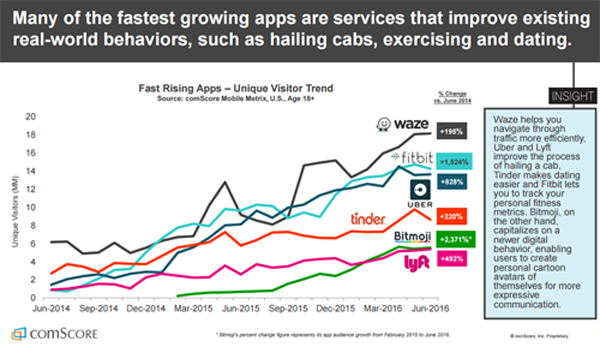 Some of the fastest-growing mobile phone apps help people manage life-tasks every day, like getting real-time directions when driving, finding dates, getting rides, and tracking health, according to The 2016 U.S. Mobile App Report from comScore.
Some of the fastest-growing mobile phone apps help people manage life-tasks every day, like getting real-time directions when driving, finding dates, getting rides, and tracking health, according to The 2016 U.S. Mobile App Report from comScore.
The chart from the comScore Mobile Metrix survey illustrates some popular apps well-used by people on smartphones, with one of the fastest growth rates found for the Fitbit app — 1,524% growth over two years, from June 2014 to June 2016. In comparison, the Uber app visits increased 828% in the period, half as fast, and the Tinder app, 220%.
Some key topline results of this annual report are that:
- Smartphone apps now consume 80% share of growth of digital time spent by people
- App use time has increased across every age group. While highest among Millennials, note that the usage time of mobile apps among people age 55-64 grew the fastest at 37% in the one year, June 2015-June 2016, with over 55 monthly hours. People age 65+ scored 42 hours on average per month on smartphone app visits, versus over 93 hours per month for people age 18-24.
- The 10 most popular apps by unique visitors to June 2016 (year-on-year) are Facebook, Facebook Messenger, YouTube, Google Maps, Google Search, Google Play, Gmail, Pandora Radio, Instagram, and Amazon Mobile. Note that the top 7 are owned by either Facebook or Google.
- Most time on smartphone apps is concentrated among a few apps owned by very large internet companies.
The report’s data is based on behavioral measurement from comScore’s Media Metrix Multi-Platform, which looks at consumers age 18 and over and unique visits to an app or digital media property at least once over the course of a month.
Health Populi’s Hot Points: Mobile health is emerging as a complement to primary care at the doctor’s office or clinic. A health consumer can access a visit to a physician using the AmWell (American Well) app, track blood glucose and manage Type 2 diabetes via the MySugr, check lab test results on MyQuest from Quest Diagnostics, and find well-priced prescription drugs on GoodRx.
The evidence base is growing that mobile tools can help people bolster their health. New research from Walgreens published yesterday shows that the company’s Balance Rewards loyalty program has driven greater medication adherence. Specifically, Walgreens researched the relationship between BRhc engagement and adherence to antihypertensive, oral antidiabetic and antihyperlipidemic medications for patients ages 50 and older. The results:
- Balance Reward programs members tracking physical activity had greater rates of medication adherence: 11.2% higher for people managing hypertension, 5.1% greater for people managing diabetes, and 4.5% higher for people managing high cholesterol.
- For members tracking blood pressure or blood glucose, Walgreens observed greater optimal adherence: 6.8% greater for consumers using anti-hypertensives, and 12.3% higher for people taking drugs to manage diabetes.
From a user-design standpoint, one intriguing observation comScore uncovered is that 35% of smartphone users age 55 and over only ever operate their smartphone with two hands. This is 6x the rate of people 18-34 who multi-task and use their phones single-handedly (only 6% using two hands to navigate their phones).
To gain adoption and sustained use of a mobile health tool, Job 1 is to be user-centered and Know Thy Patient. If they’re older people, they may fall into the “two-handed smartphone” user, and will have other unique life-flows to consider. One size won’t fit all. But one lesson from Walgreens is that social community and behavioral economics can help nudge people toward sustained use that can make a real difference in peoples’ health and wellbeing.




 Thank you FeedSpot for
Thank you FeedSpot for